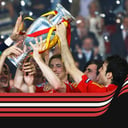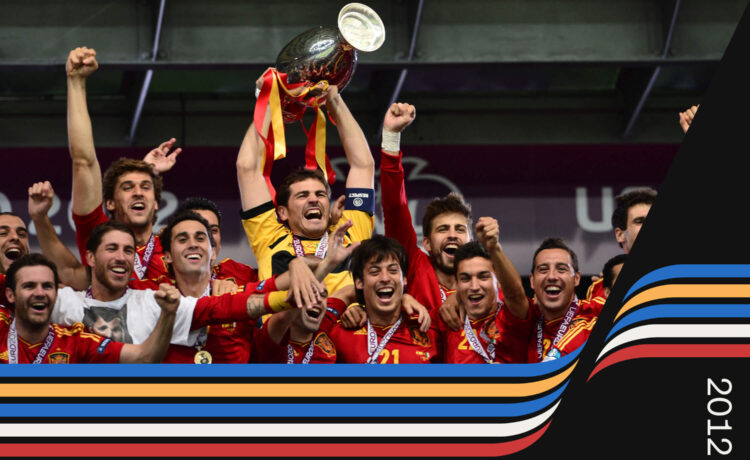This is the latest in our fortnightly series about the 16 triumphant teams in the European Championship before the 17th edition is played in Germany this summer.
We’ve looked at the Soviet Union in 1960, Spain in 1964, Italy in 1968, West Germany in 1972, Czechoslovakia in 1976, West Germany again in 1980, France in 1984, the Netherlands in 1988, Denmark in 1992, Germany in 1996, France in 2000, Greece in 2004 and Spain in 2008. Now it’s time for Spain’s successful defence of the trophy in 2012.
Introduction
The only time the European Championship has been successfully defended and by a familiar group of players from the 2008 edition.
That said, the likes of Marcos Senna and Joan Capdevila were long gone, Carles Puyol and David Villa were out through injury, and Spain had a different manager – so this feels like a very different side from Luis Aragones’ adventurous, fluid and highly popular winners from four years earlier.

GO DEEPER
How Spain won Euro 2008: A change of style, a sense of adventure and the steel of Senna
The manager
Vicente Del Bosque was pure Real Madrid. Aside from a couple of loan spells, Del Bosque spent his entire career with them, making nearly 350 appearances and winning five titles. He also won 18 Spain caps and featured at Euro 1980 in Italy.
As manager, he coached Real’s youth side, then became an assistant and caretaker boss on a couple of occasions, before taking over in 1999. He was controversially dismissed in 2003 despite winning La Liga, ruled himself out of the national job in 2004, and instead experienced a difficult half-season in Turkey with Besiktas. But he was announced as Aragones’ successor a few months before Euro 2008.

A genial, statesmanlike figure, Del Bosque’s managerial style was more based on preserving squad harmony than making decisive tactical moves. At a time when the Clasico rivalry was at its peak and the Spain side was dominated by Barca players, he managed tensions well.
Tactics
Different from that of 2008, although very similar to the World Cup-winning campaign two years earlier. Compared to the Aragones era, Del Bosque essentially used one fewer attacker and one extra midfielder.
Sergio Busquets was roughly playing the Senna role but had a solid partner alongside him in Xabi Alonso. This meant Xavi Hernandez playing from the top of a midfield triangle, a role he disliked, with Andres Iniesta out on the left. And whereas Spain sometimes offered serious directness from the other wide role, with the likes of Villa, Pedro Rodriguez and Jesus Navas all used to good effect at the World Cup, throughout this tournament, Del Bosque favoured David Silva. Essentially, Spain had five ball-to-feet midfielders, which sometimes made them narrow and predictable.
This style was exacerbated by the fact Spain didn’t have a reliable No 9 either, with Villa out and Fernando Torres, the hero of the final in 2008, having endured two years of dreadful form at club level. Del Bosque surprisingly started the tournament in a 1-1 draw against Italy with Cesc Fabregas up front, which basically meant he was using six midfielders. Spain hadn’t worked on that system in training, Fabregas played very deep and Spain simply played in front of Italy.

Cesc Fabregas, centre-forward (Alex Grimm/Getty Images)
Torres came into the side for a 4-0 thrashing of a terrible Ireland side handicapped by goalkeeper Shay Given’s lack of mobility, and he retained his place for the 1-0 win over Croatia, although he was substituted after an hour, with his replacement Navas scoring the only goal.
Del Bosque returned to using Fabregas up front for the 2-0 win over France, then brought in Alvaro Negredo for the goalless draw in the semi-final against Portugal. He was a proper penalty-box striker but felt disconnected from the rest of the side. Then, finally, for the final, Fabregas returned up front again and while he’d started the tournament playing like a sixth midfielder, in the final he showed more willingness to play high up and run in behind. Realistically, Del Bosque never decided upon his best approach in the final third.

You might be surprised to learn…
Despite dominating possession like no one else in European Championship history and scoring a respectable 12 goals across their six matches, Spain were widely decried for being boring throughout this tournament. This seems strange in hindsight when you look at the players involved and watch the highlights, where Spain score lovely goals after neat combination play and selfless passes. But the knockout games against both France and Portugal were dull, defensive, dreary affairs.
Possession football isn’t to everyone’s taste, but it’s notable that among the critics of Spain’s football was Arsene Wenger, a man who had arguably become more associated than anyone else with the concept of attractive football.
“Throughout their years of success, they have tried to keep the same philosophy, which is based around wanting to have the ball,” Wenger wrote in a column for Eurosport before the final. “Although they have struggled to score goals, they are the masters of possession, they are the best in the world technically and I have big respect for what they have done… however, they have betrayed their philosophy and turned it into something more negative. Originally they wanted possession to attack and win the game; now it seems to be first and foremost a way not to lose.”

(Shaun Botterill/Getty Images)
Key player
Spain’s best player and their key player were positioned down the same flank.
Iniesta won the player of the tournament award, the final essentially determining that he would receive that honour ahead of Italy’s wonderful Andrea Pirlo. Playing to the left of the attack, this was Iniesta at his best, receiving balls in tight spaces, driving towards the opposition and slaloming past challenges.
Twice in this competition, famous photos were taken of Iniesta seemingly taking on opposition defences single-handedly, bringing to mind the famous image of Diego Maradona against Belgium from World Cup 1986. But whereas the Maradona photo was a little misleading and actually the aftermath of a defensive wall splitting, the Iniesta photos were more telling. Spain simply weren’t attacking with enough players for Iniesta to have any support and he was often leading the charge solo. In a way, that was a depressing reality for a side supposedly based around teamwork, and for all of Iniesta’s technical flair, he wasn’t the type who could win games on his own.

(Pressefoto Ulmerullstein bild via Getty Images)
Because of Spain’s caution, their key player was the left-back, Jordi Alba. A much more dynamic replacement than his predecessor Capdevila, it was Alba who offered the speed, verticality and width lacking from further forward. Such was his importance to Spain’s attacking play that, ahead of the quarter-final, France manager Laurent Blanc decided to deploy two right-backs in tandem, with Mathieu Debuchy ahead of Anthony Reveillere. Stopping the Iniesta-Alba duo was the plan.
But the plan failed when Debuchy slipped over trying to keep up with Alba’s burst to the byline and his measured cross found Alonso, making an uncharacteristic run into the box, to head home the opener. Alonso would also score Spain’s second from the penalty spot, perhaps the only time he took centre-stage for the national side ahead of the Barcelona players.

(Martin Rose/Getty Images)
The decisive moments
Having failed to sparkle for much of the previous two games, Spain scored two brilliant goals to effectively win the final against Italy before half-time. The opener featured Xavi in a deep position, passing forward to Iniesta between the lines, and his through-ball finding Fabregas running in behind – something you’d never have seen in the first meeting between the sides. Fabregas’ driven, high cutback was nodded home perfectly into the top corner by Silva. This was Spain’s front four combining to penetrate the opposition. At last!
The second was completely different: now, Spain were being direct. Xavi received the ball on the halfway line and Alba burst past him and in behind. Xavi’s through-ball was precise, Alba controlled it perfectly and calmly finished past Gianluigi Buffon. This wasn’t the Spain of the previous five games, but it was the Spain that everyone now remembers.
The (rest of the) final
A sign of Spain’s dominance of European football was the fact that Italy, traditionally considered the most cautious of the major nations, had reformatted their approach and attempted to play more open, expansive football. Manager Cesare Prandelli had been appointed because he had a reputation for playing possession football and he deployed a midfield diamond of Daniele De Rossi, Andrea Pirlo, Claudio Marchisio and Riccardo Montolivo — stylistically, a very ‘Spanish’ approach, with various playmakers together.
But Prandelli encountered injury problems. First, Giorgio Chiellini went off after 21 minutes. Then Prandelli introduced Antonio Di Natale in place of Antonio Cassano at the break. And before the hour mark, he used his final substitution, replacing Montolivo with Thiago Motta (who had come through at Barcelona and played with Xavi and Iniesta). But Motta tore his hamstring after a couple of minutes and Italy had to play for half an hour with 10 men.

Thiago Motta’s injury in the final forced Italy to play with 10 men (Shaun Botterill/Getty Images)
And now, for the first time, Spain were ruthless. You expected them to play keep-ball and ‘declare’ on a 2-0 win, but Pedro came on for Silva, Torres for Fabregas and Mata for Iniesta — essentially all attacking moves. Torres made it 3-0, with his third goal of the tournament making him one of the competition’s six joint-top scorers, before he slipped in Mata to make it 4-0. Poor old Italy, who had commendably progressed through to the final with Spain-style football, were now the victims of Spain’s desperation to finally beat strong opposition convincingly.
Were they clearly the best team?
Probably. Germany arguably looked the best side up until the semi-final, but they turned in a weak performance against Italy, losing 2-1 and denying us a Spain vs Germany final, which feels like it might have suited Germany’s dynamism and counter-attacking ability.
And if Raul Meireles hadn’t passed behind Cristiano Ronaldo on the break in the final minute of the goalless semi-final, which forced him to check his stride and shoot with his weaker left foot on a tight angle, neutrals probably would have been pleased that Spain’s lack of ambition in possession had come back to bite them.
But Spain were tremendously difficult to beat. They conceded an hour into their opener against Italy and then didn’t let in another goal for the remaining 510 minutes of the tournament. As in 2008, they needed a shootout victory after a goalless draw in one of their knockout games, but otherwise, it’s tough to argue against the idea they were the best side.
(Top photo: Guiseppe Cacace/AFP via Getty Images)

















